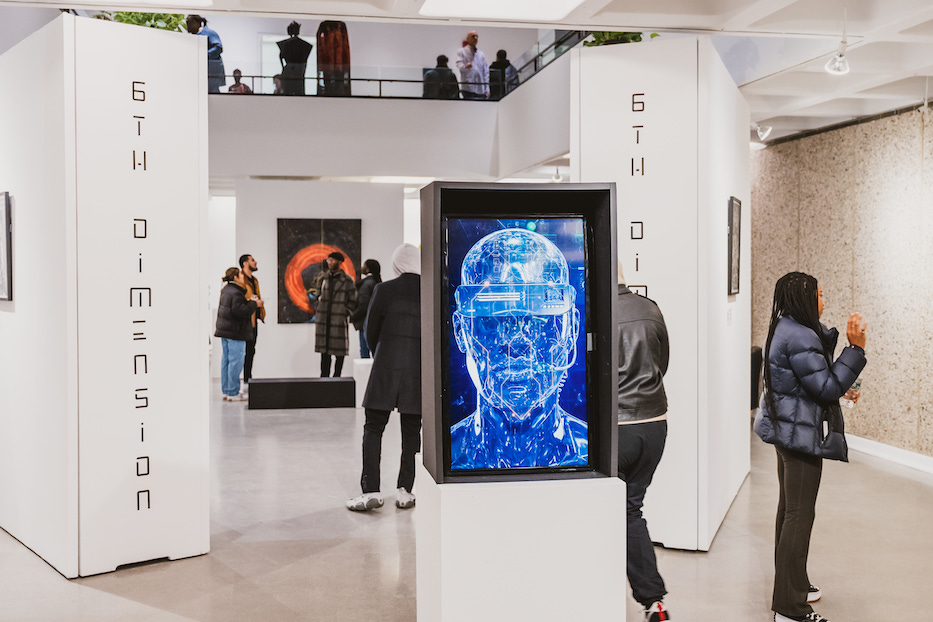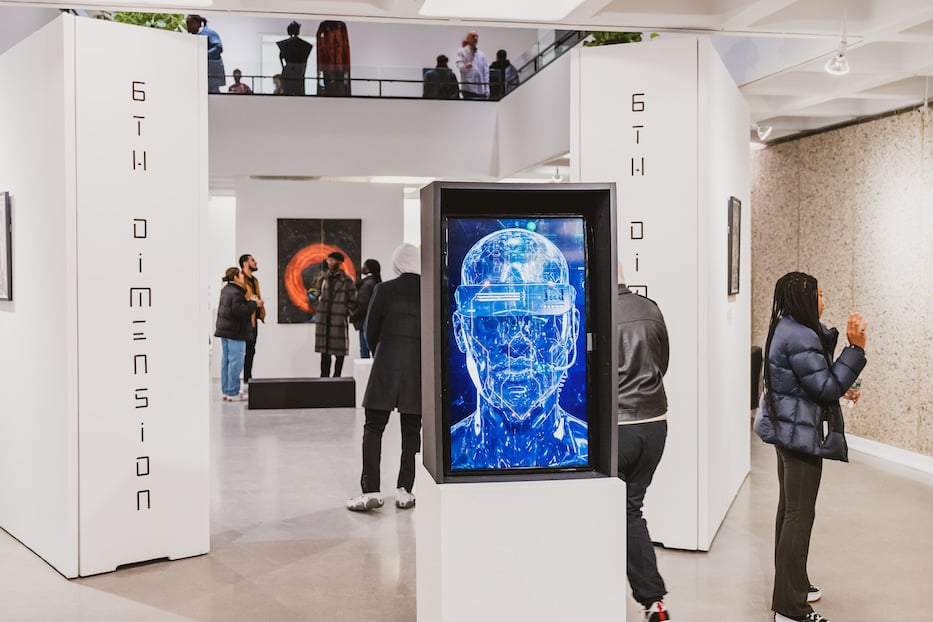
Culture & Community | Arts & Culture | Visual Arts | Arts & Anti-racism | New London | 6th Dimension Festival

A generation of creatives is challenging the ways in which we think about Black realities–often overshadowed in news headlines by pessimism or grief. With the loss of Tyre Nichols recently to the hands of police violence, this picture seems inevitable. Yet the weight of this view can limit our sense of agency or ability to look forward with new perspectives.
The trajectory of work under the banner Black Futures, Technologies of Joy, AfroCyberPunk and Afrofuturism aim to expand this conversation. Genres like speculative fiction, fantasy and sci-fi are emergent among visual artists, with contemporary musicians giving homage to astral elder players like Sun Ra, Alice Coltrane and Pharoah Sanders.
6th Dimension, an exhibition now running at Connecticut College in New London, builds upon these themes, featuring an array of artists employing interdisciplinary strategies and multimedia tools. The curator of the exhibition is Juanita Sunday, who is also an event producer for the International Festival for Arts & Ideas. Raised in New London, Sunday is now based in New Haven.
6th Dimension is the second show Sunday has produced at Cummings Art Center, and her fourth exhibition in total. The artworks take up two levels of the gallery, and the range is impressive. There are traditional paintings and drawings bearing cultural, spacial, and mechanical markings, intricately cut fashion pieces serving as wearable technologies, 3D virtual worlds and digital collages, regal in detail, augmented with video animation.
The following is an interview between writer and artist Reggie Woolery and curator Juanita Sunday.
.jpg?width=933&height=622&name=The6thDimension-69%20(1).jpg)
Keila Myles, Mars (bottom center) | Aishatu Ado, African Steampunk Series (top far left wall) | Tea Montgomery, Heroes Collection (center mannequins) | Ira Revels, Igbo Polygonal Tribal Mask, 2055 (far right back wall) | Kern Bruce, I & III (bottom left wall). JOËL Cintron Photos.
Reggie Woolery: Where did you get the inspiration for 6th Dimension?
Juanita Sunday: I previously curated an exhibition for Connecticut College and was given the opportunity to do something new. The idea really came to me in the shower. I wanted to try and put together an exhibition that explored Black realities across time and space. I’m a big sci-fi person, a big fantasy person, I draw a lot of inspiration from those mediums and genres. I enjoy stories that have to do with time travel, those are the ones that always suck me in. So, all these things that I love were the initial thinking for this exhibition.
Then, going a little deeper, I realized Afrofuturism had been on my mind for a couple of years. I took a workshop around this theme where one of the activities was to create a world of your own. The process really opened my mind to how I look at and experience things around me. Afrofuturism then becomes a framework, a tool that helps us look into the future while reflecting on the past, providing a pathway to create solutions for problems today. I want people to leave 6th Dimension open to a different way of thinking.
People are familiar with the concept of Afrofuturism from movies and pop culture, but I look at it in a different way. The exhibition uses surrealism and fantasy to question reality and why things are the way they are, to change the way that we see and experience ourselves–to think outside the norm, to actually create out of the box solutions. It's very easy to think things are the way they are and will never change. But why? Why are things this way?
RW: I previously worked at Charles H. Wright Museum of African American History in Detroit, which is a first voice institution, meaning the stories, the history is from an African American perspective, rather than colonists per se. Is this similar to the principles of Afrofuturism?
JS: Afrofuturism is about putting the Black people and their experiences first, focusing on how we navigate the world. Another principal is approaching other people with love and respect in how we come up with solutions. More generally, nothing is impossible. I think this is a great way to move through the world for anyone, especially for Black people. No matter what the social conditions or how white supremacy is put upon us, none of these things have to define who we are or who we become.
RW: What is the relationship between prior shows you’ve curated, not under the Afrofuturism banner? Is there a difference or a harmony?
JS: Definitely a harmony with previous shows. I am the child that questioned things, was a little rebellious. My family has celebrated Kwanzaa religiously for the last 30 years, which I think is inherently Afrofuturist. So, in the last two or three years, it’s been about putting a name to these ideas and concepts that I always was connected to. I grew up drawn to sci-fi and fantasy, but now there is a concept, a collective, a group of people who use this in their art, use this in their studies, that is actually a movement, and a thing.
In terms of curatorial practice, this is my fourth show. Each of the exhibitions have centered on Blackness, the Black experience. That is where my mind lives. I create for Black people. My work is a love letter to Black folks. The show before this one was NAPPY, focused on Black hair. RECLAIMED, explored the African traditional religions, like Voodoo and hoodoo, spiritual practices that have been lost to African American people or had derogatory meanings placed upon them. These shows attempted to reclaim some of those lost things.
RW. What made you think that being a curator, a producer, a shaper of bringing people together in space was something you wanted to do?
JS: It came from working at a nonprofit art gallery in New London, as a gallery assistant. In that role I was responsible for doing all of the programming, marketing, everything. I assisted with hanging the shows and working with the artists. I think that experience, seeing how all the pieces come together, sparked my interest in becoming a curator. I submitted my first proposal for an exhibition at that space. Also, my educational background is in digital design and interactive media, so for all my exhibitions, I produce the promotional graphics and web design. Being an event producer as well, I give thought to the programs surrounding the exhibition. There is focus on the experience people are going to have. So, in my curating, yes to the art, but also how am I getting people to interact with the art and with each other in the space?
RW: Have you considered doing exhibitions in clubs or where Blacks folks congregate as opposed to the white cube gallery?
JS: Absolutely. I opened my own art gallery space, Cultured AF, in 2019. The concept of the space was as an art lounge. It wasn’t a white wall gallery. It was more like my living room, a place where people could sit and be with the work, play a video game or board game, and be in conversation with each other. I hosted comedy shows there and open mics.
RW: I love that. I’m thinking of instances where I’ve been at shows and seen people pass by artworks that were more abstract or maybe they didn’t think were for them.
JS: The idea of taking art and putting it in spaces that people already use is something I’m definitely in support of. This exhibit will travel to other locations in Connecticut. The ultimate would be to have it in multiple spaces at one time. The more I do these projects, the more I see the lane I want to be in and where my true passions lie.
RW: Can you point me to two to three Connecticut-based artists in 6th Dimension and suggest why you selected them?
JS: I love creating exhibitions that allow people at different levels to be in the same space together. I just think it creates a wonderful dynamic of experiences. Some of the artists in the show I am very familiar with and have worked with before, such as Greg Aimé and AnUrbanNerd. This is the first exhibition Keila Myles has been in. Other artists, such as Alisa Sikelianos-Carter are more seasoned and have shown work globally.
Greg Aimé is a media artist working in digital collage. His practice has really progressed. Him and I talked about how the degree of detail, the range of light and coloring has grown and is so beautiful. As someone coming from digital media, I love the animated augmented reality aspects of his collages. He is including in this show three new pieces and one older one.
Alisa Sikelianos-Carter asserts Black futures as a manifestation of the sacred and divine technology, both as a means of survival physically and metaphysically. She creates these different worlds in her pieces. She also has a body of work focused on future ancestors, which is Afrofuturist in itself. In the exhibition, there are two paintings, 4’ x 4’ all black with texture that hides so much detail underneath.
Keila Miles is a performing artist, wonderful musician, and painter. Looking at her work online, seeing her style, I could tell she already lives in this Afrofuturist space and could create something unique for this exhibition. And generally, that is how I work as a curator, I find artists I believe can make something that fits this theme, rather than choosing specific artworks. I want the artist to be connected to the theme. Keila created a piece, Mars, which is about 4’ x 5’ tall.
Initially, she submitted a couple pieces that I didn’t think were quite right. I reached out and said 'If you can’t do this show, there is another coming up where you might do a piece.' And she responded that she wanted to be in this exhibition, and said she would rework something. Keila actually began a new piece and documented her process on Instagram. So I saw some of the previews before I saw the actual work, and it's glorious, it's so beautiful.
RW: Let’s touch on that a little bit more. There are lots of artists, lots of Black artists in Connecticut, but there aren’t necessarily many people whose chosen role is to support, nurture and challenge. How do you experience that role of studio visits, talking with artists?
Honestly, when I initially got the work in from Keila, I was so hesitant to tell her it might not fit what we are trying to do. It was a good lesson for me. Part of that curator’s role is to nurture, as you said, and educate and challenge. We’re living in this time where artists might feel they just have to create content for Instagram, or overproduce because they have to sell and make money. But where can artists have that space to critique or be challenged if it's not in a traditional school setting? Artists who are self-taught or work kind of in a silo, where can they go and trust someone with their process and ideas? That’s really important and needed.
6th Dimension runs at the Cummings Art Center, Connecticut College, New London through March 9, 2023. Featured artists include Aishatu Ado, Greg Aimé, AnUrbanNerd, Clifford Bright-Abu, DarkMythst, Winter Dior Hart, illFormative, KIN, Tea Montgomery, Keila Myles, Ira Revels, Alisa Sikelianos-Carter, Kern Bruce A gallery talk is scheduled for Saturday, Feb. 18. For more information, visit the exhibition's website.
Reggie Woolery is a artist, writer and educator living in North Haven, CT

